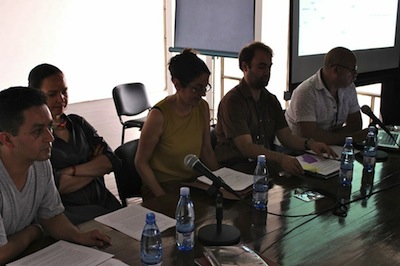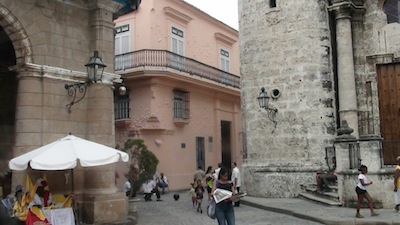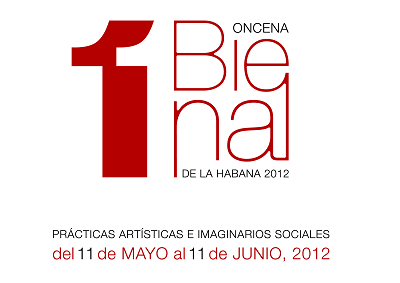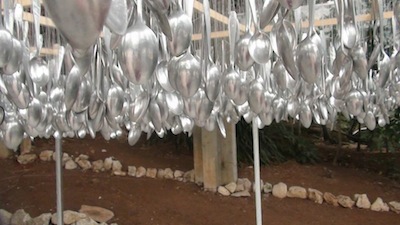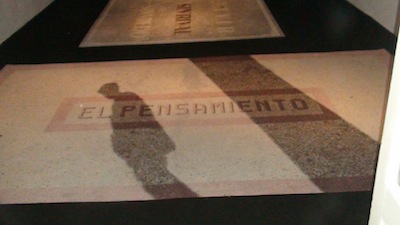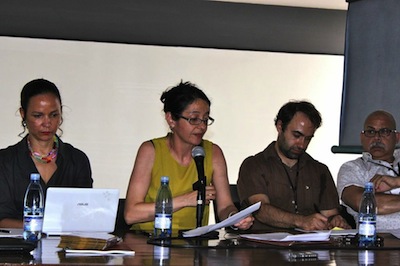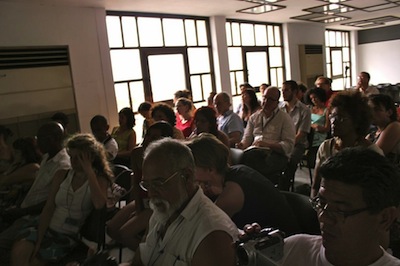The Biennial Statement
The written curatorial statement from the organizing committee of the 11th Havana Biennial arrived via email the same day that we were preparing a dossier for the Romanian magazine IDEA. As we put together a brief history of “Decolonial Aesthetics” meetings and some portions of the “Decolonial Manifesto,” we discussed the need to bring to the biennial some of the critical and creative processes emanating from the decolonial collective. Previous editions of the biennial were overcharged with doses of “postmodernity,” marginal notes on the “postcolonial” condition, and celebrations of the “altermodern” (with its postproduction and relational dimensions). These were present in the curatorial practices, as well as in several of the presentations at the Theoretical Forum during the 2006 and 2009 editions. As we kept reading through the Biennial‘s curatorial statement, its content promoted a heated discussion among us where the idea of presenting a panel on decolonial aestheSis at the Havana Biennial became seen as not only relevant, but also, and above all, necessary.
Since 1984 the Havana Biennial has been known as “the tri-continental art event,” and is commonly called “the poor biennial” — as it presents artists from Latin America, Africa, and Asia. The Biennial also holds intense debates about the nature of recent and contemporary art from a Third World or Global South perspective. The Biennial is a product of Cuba’s fruition since the revolution of 1959, and of the cultural policy developed after the Cuban constitution’s amendment in 1976. The Wilfredo Lam Center, created in 1983 after the passing of the well-known Cuban artist, has organized the Biennial since its inception (using Lam’s tri-continental background as its symbolic engine). The Havana Biennial has been addressing an alternative cosmopolitanism (that became an existential internationalism during the “contemporary” moment) embraced by a group of local cultural agents, critics, philosophers, and art historians, and also supported by a network of peers around the world. Historically, the role of Armando Hart Dávalos, Minister of Culture of Cuba (1976-1997), was seminal in the development of a solid cultural policy, which produced, among other projects, the Havana Biennial, based on an explicit “Third World” consciousness. The imprints of critics and curators Gerardo Mosquera and Nelson Herrera Ysla, key members of the founding group of the Biennial, and of Llilian Llanes, director of the Lam Center and of the Biennial (1983-1999), have further shaped the event in both structural and conceptual terms.
Patricia Villalobos (Nicaragua/EEUU)
Salpullido, 2012
Poliestireno sobre pared, Dimensiones variables
Vista de la instalación
Pared exterior del Centro de Arte Contemporáneo Wifredo Lam, Centro Histórico
La Habana
Nowadays, the Biennial is nested at the Lam Center, and it works in concert with Cuba’s cultural apparatus as part of the Directorate of the National Council of the Arts and of the Ministry of Culture. However, its curatorial team (along with the director) decides, with some autonomy, the topics and programing each edition of the event will address.
The authors of this report have been participating actively in the Biennial, not only as visitors, curators, guest speakers, and researchers, but also by producing critical readings and establishing networks only possible in the advent of the event.[i] We were intrigued by some of the sections of the curatorial statement for the 2012 edition:
When we speak of social imaginary, we are not referring to a theoretical body, but to the way people imagine their social space and express themselves through cultural and historical references, and to the symbolic dimension they acquire through art. . . . Nowadays, the exhaustion of old models of social and institutional representation lead to the search for harbors and cultural connections as ways of vindicating new forms of coexistence and socialization; these imply other ways of perceiving and understanding culture. . . . The task now is not to retake the imaginaries that constitute a tradition, but to think about how to create discourses that imply or commit the citizen and the observer on a more complex scale.[ii]
Our panel was organized as a response to certain aspects of the curatorial statement that we describe below.
Havana’s Collective Experience
Many of the members of the decolonial aestheSis collective are practicing artists, theoreticians, curators, and writers who arrive to the process as a result of understanding the way in which the axis of coloniality and modernity/rationality (as Anibal Quijano puts it in his inaugural article) still resonates and maintains the debates about art, art practice, and the institutions that support it. This frame allows us to see how the coloniality of knowledge is present in places with colonial histories such as Cuba, its colonial legacies complicated by the Cuban Revolution, which was carried out based on the socialists’ emancipatory principles of the European Enlightenment. The coloniality of knowledge is evident in art schools and museums, as well as in their curricular programs (textbooks and research volumes), curatorial practices, and critical debates. If coloniality is still at work, then decolonial responses are of the essence.
Marcos Agudelo (Nicaragua)
Suéñate Muerto, Teología de la Liberación, 2011
Instalación, video, piedra
25 x 20 x 6 cm
“Decolonial aesthesis” originated in South America and was founded on the need for creative practices and a theoretical body of work that attempt to delink from the Anglo-Eurocentric creative paradigm.[iii] Delinking is a liberating project and healing process at the same time, healing from the colonial wound (see Shilliam below) — the epistemic and aesthetic racialization bound in modern aesthetics (Kant), which remains implicit in postmodern and altermodern aesthetics. The authors of this report and participants in the Havana Biennial panel agreed that the theoretical event at the 2012 Havana Biennial would be strategic in the dissemination of the “Decolonial AestheSis” discourse, practice, and option. We started by organizing not only an event-action-panel to reach Caribbean audiences (and visitors to the Biennial), but also a platform to share decoloniality at large in Cuba. After the collective’s gatherings in Bogotá and Durham, the published manifesto, the dossier for IDEA, and the scheduled projects in Germany (Berlin and Kassel), Havana seemed the next strategic move.
As we were imagining our presence at the Havana Biennial, we discussed how the decolonial option is as old as coloniality itself; it can be linked to the silenced voices of Indigenous and Afro descendants while struggling to survive the formation and transformation of the colonial matrix of power. Glimpses of decolonial grammar can be found in Aztec and Mayan codices composed by indigenous persons after the conquest and also by dissident mestizos, mulattos, and creoles of the conquest, as well as during and after the wars of independence in the Americas. More recently, this grammar has appeared in the work of Caribbean intellectuals and among leaders in the postcolonial struggles in India and Africa. However, in academic terms, the decolonial option as an epistemic, aestheSis, political, economic, and ethical project has its point of origination in the Americas. For several decades now scholars from the region have been working collectively, meeting, collaborating, and debating the multiple facets of the issue.[iv]
Maksaens Denis (Haiti)
ViVi (Verbal Intellect Visualist), 2012
Instalación de video, Dimensiones variables
Pabellón Cuba, Vedado, La Habana
By the time we arrived at the 2012 Havanna Biennial there was already a plethora of work being done: publications, workshops, meetings, conferences, events, seminars, courses, and, more recently, exhibits. A collective of decolonial citizens leading the modernity/coloniality project have been present in many intellectual and scholarly venues. In responding to such a process, in November of 2010, an exhibit, an academic event, and the public presentation of an issue of the journal Calle 14 took place in Bogotá, Colombia.[v] A catalog of the exhibition and workshop was published after the events. In May of 2011, a workshop and an exhibit titled “+DECOLONIAL AESTHETICS” was organized at Duke University by the Center for Global Studies and the Humanities, following and expanding upon the Bogotá event.
The organizers of the 2012 Havanna Biennial were aware of this development. We knew of their interest in engaging with this topic in the seminars that are organized in parallel to the exhibits. We then contacted officials of the Biennial with the idea of organizing a workshop/panel to introduce “Decolonial Aesthetics” at the theoretical forum of the event. We aimed at creating a collective discussion on how decolonial transmodernity and aestheSis are bringing coloniality to the foreground, unveiling the darker side of modernity that continues to be a blind spot in the debates on postmodernity and altermodernity. We explained to the curators how, in a parallel and reverse direction, decoloniality has been steadily challenging the hegemony of the modern/colonial matrix and its territoriality, particularly in relation to art, art practices, philosophical conceptualization of aesthetics, and institutions of the art world.
Marcel Pinas (Suriname)
Sanfika, 2012
Instalaciones, Dimensiones Variables
Pabellón Cuba, Vedado, La Habana
The curatorial team of the Havana Biennial asked us to further develop the argument for our proposed panel. They were not making a distinction between coloniality and colonization, and while we agreed that colonization is over in South America and the Caribbean, with some exceptions, we argued that coloniality never ended, is still present, and has no visible end in the near future. We responded that the subjects of coloniality today, the colonized, are voicing their concerns on the devastating consequences of new forms of modernity/coloniality/rationality. If, then, coloniality is still well and alive, and is engrained in current modern, postmodern, and altermodern conceptualizations of art, artistic practices, and aesthetics, then “decolonial aestheSis” is a necessary response and contribution to the coloniality of knowledge and being, and also a way to delink from the darker side of imperial globalization. Decolonial AestheSis seeks to recognize and open options for liberating the senses. This is the terrain where artists around the world are contesting the legacies of modernity and its re-incarnations in postmodern and altermodern aesthetics, including the consequences that are perennially hidden by and embedded in notions such as “linear time,” “progress,” “development,” and “innovation.” As witnesses to and victims of the ongoing modernity and coloniality/rationality Anglo-Eurocentric project, and as artists and thinkers, we have to contest this state of affairs. We reaffirmed that our intention for presenting a panel on decoloniality at the Biennial was to create a critical space where the question of the “decolonial imaginary” would reach a constituency that historically has been able to construct the grammar of the decolonial. We further argued that the panel proposed a trans-modern gesture where artistic practices, critical thinking, and social interactions would cease to engage in the normalized Euro-centered conceptions of human existence and sociopolitical dynamics.
Carlos Garaicoa (Cuba)
El pensamiento, 2010
Tapiz de algodón, lana, trevira-cs, lures, algodón mercurizado y acrílico
286 x 478 cm
Galería del Centro de Arte Contemporáneo Wifredo Lam, Centro Histórico
We also brought to the Biennial curators’ attention that coloniality does not operate anymore in tobacco and sugar production, or in the slave trade, but in the control of global finances, public opinion (via the production of hegemonic imaginaries through media), the art market, and subjectivity in order to perpetuate and magnify the salvationist rhetoric of modernity. For the decolonial option, identities, identification, denaming, and delinking are crucial processes because they assist in unveiling the hegemonic legitimacy of “knowledge” intrinsic to modernity, which denies agency, validating the identities it constructed in the first place. Emerging between the monoculture of globalization and regional nationalist cultures, the decolonial establishes itself as an option of delinking from both globalism and nationalism by means of promoting transnational identities-in-politics beyond the globalized market, the state, institutional religions, and normalizing aesthetics.
After accepting our arguments, the curatorial team formally invited us to participate in the 11th edition of the Havana Biennial, titled Artistic Practices and Social Imaginaries. The conveners for the panel, Raul Moarquech Ferrera-Balanquet (Cuba-USA-Mexico) and Miguel Rojas-Sotelo (Colombia), invited a small group of peers: Dalida Maria Benfield (USA/Panama), Alanna Lockward (Dominican Republic-Germany), Pedro Lasch (Mexico/USA), and Pedro Pablo Gomez (Colombia) to be part of the Theoretical Event to take place at the 2012 edition.
As a panel, we were invited to write about our participation at the Biennial for the Montreal-based publication Inter Actual. On the spirit of our collaboration, the participants, employing online tools, produced a collective text where we shared our views about decolonial aesthetics, its points of origination, its arguments, and its relation to artistic and intellectual practices. The collective essay was titled “Decolonialidad y experiencia aiestètica: una aproximación.” (Decolonialism and Aesthetic Experience: An Approximation). The exercise built upon the decolonial aesthetic manifesto, the series of exhibitions and workshops, our collective participation in conferences, and the common platforms of collaboration we have developed. [vi]
Simultaneously, at the request of the Biennial‘s leadership, individual texts were produced as companions to the collective’s text to be delivered at the Theoretical Forum. Alanna Lockward, who is now based in Berlin, proposed a paper titled “Decolonial Diasporic Aesthetics: Black German Body and Politics”; Cuban American Raúl Moarquech Ferrera-Balanquet decided to present a research drawn from the studies of the Haitian’s Vèvè as a contemporary practice, titled “Aiesthesis Decolonial Transmoderna“; Miguel Rojas-Sotelo and Pedro Lasch named their intervention at the panel “El Narcochingadazo: Common Aesthetics, a Time-based Practicum”; Dalida Maria Benfield put forward an analysis of “Third Cinemas/Third Spaces: A genealogy of decolonial aesthetic production”; and Colombian curator and scholar Pedro Pablo Gomez suggested a conceptual introduction to decolonial aesthetics from the experience of Colombia, “Estéticas Decoloniales: Una Mirada desde Bogotá.” All the texts are part of the volume (in production) for the Theoretical Forum of the 11th Havana Biennial.
Decolonial AestheSis in Cuba
Understanding the context of the Biennial, and Cuba as a larger port/platform, and having experienced the knowledge exchange that took place in previous encounters, we imagined a “creative space” where we, the members of the panel, could debate internally about the decolonial option and the strategies developed by each of us. When we learned that Ferrera-Balanquet’s family would be able to host the group, after obtaining permission by the Cuban officials at the Biennial, the group arrived in Havana from different locations around the globe. In the midst of fresh Cuban coffee, the abundance of tropical fruit, the welcoming of a Cuban family and friends, the sound of the waves crashing against the Malecon, and the salty air from the ocean, lively conversations starting to flourish regarding the diverse decolonial strategies we have incorporated into our daily lives, scholarship, and creative practices.
Guillermo Rodríguez Rivera (Argentina/Puerto Rico)
La inhabilidad de prever la praxis, 2012
Instalación al aire libre, textiles y hierro fundido
Malecón de La Habana
Interactions with other participants and Biennial organizers became part of the group’s daily tasks to explore future collaborations and spaces of dissemination of the decolonial option. Caribbean time is slower than the pace of Western time, allowing us to open up the space for other voices to appear–including new collaborations with individuals and groups such as Arlan Londoño, the e-fagia collective, and the Cuban curator Dannys Montes de Oca Moreda–and further networks were established. Sharing family time in Cuba allowed the group to confront the diverse realities we come from and the ways we make operational our own identity-in-politics. Indeed, that is not a simple task: we are bounded not only by chronological time and the barriers that set in, but by coloniality itself, an imprint all of us have internalized. Decolonial options in all spheres of life call for a surrender of the individual and the linear ways we have been trained. The experience of delinking happens only when we make evident such limits and when we test our own demons.
Cuba, Havana, and the Biennial proved to be a relevant space/time/speed to reflect about the decolonial as an option closer to our subjectivities. For several days, from dawn to dusk, the group retreated at Ferrera-Balanquet’s family house in an almost monastic way. There we reflected about the strategies the decolonial option offers, and how we have built them in our own creative processes: decolonial trans-modernity, which helps to locate practices outside the colonial matrix and beyond its control of time (speed, acceleration, not to waste time, run-run-run without asking what for); cimarronaje, which entails the subversive force of communities-in-politics from an individual subjectivity that emerges living within the collective matrix; decolonial-diasporic processes, which introduced the potential of transformation in the territories of the North as the result of the clashing and compression of the worlds and the emergence of the Global South; and ancestrality, which interconnects us with the knowledge, practices, and possibilities lost and/or silenced by the hegemonic discourse of modernity.
On May 18, 2012, at the Centro Cultural Criterios, directed by Cuban intellectual Desiderio Navarro, a workshop on decolonial aestheSis took place. It was the first time the Biennial established a relationship with Centro Cultural Criterios, a center that produced one of the most relevant periodicals in the Americas, the journal CRITERIOS. According to Dannys Montes de Oca Moreda, curator of the 11th Havana Biennial, our participation in the Theoretical Event contributed to expand the context of the event:
This group (the decolonial aestheSis collective participating at the Biennial) contributes a reflexive note to the theme of the present Havana Biennial in tune with our cultural strategy of visualization and acknowledgment of the margins, but even more, it stops in deep-rooted zones of modernity-coloniality tensions, not only to provide evidence of an art practice in its anthropological terms, participative turn, opposed to the formalist emphasis of neo-Kantian aesthetics, but also to validate the plurality of aesthetics and social–even non-modern–practices that are present in contemporaneity, and against false and euphemistic universalism rooted in complex modern and global/trans-cultural networks. . . . Raul Ferrera-Balanquet, with his study of the diagrams and performative nature of Haitian Vèvè drawings as localized artistic-cultural practice that reaches our days without interference or dialogue with Western assimilation, although it anticipates many contemporary aesthetics; Alanna Lockward, with the analysis of history of concealment of the relation between the dominant Western thought, its way of mapping the world, and the constant process of development of an authentic-cultural-African thought reaching up the Black and African Diaspora of the present Europe; Miguel Rojas with the study of narco-aesthetics, its products and practices and the social destabilization it engenders; Pedro Pablo Gomez, with the theme of the cultural practice as practices of linguistic and performative positioning that reveals the colonial domination present in our daily spaces of participation; and Dalida Maria Benfield, who inquires into the production of contemporary video in different parts of the world as part of the genealogy of decolonization of a “third cinema.” These are only some of the possibilities of this multiple-disciplinary group and the research model based on decolonial studies, which makes problematic notions such as altermodernity and transmodernity that from a rhizomatic perspective of identities becomes an essential source for transformative imaginaries the group deals with.[vii]
Finally, why is it relevant to share the principles and potentials of the decolonial option within the realm of the Havana Biennial and the so-called art world? Sharing is an intrinsic element interwoven into our understanding of the global and interlocked spheres we face and live in today in politics, economics, religion, aesthetics, and epistemology. All of these spheres, interlocked and entangled, are generating a radical shift in the geography of feeling, sensing, believing, and thinking. Together with local and global social movements, the decolonial stands to see the ongoing end of Western domination, from the right and the left, in economy and politics, in knowing (epistemology, hermeneutics) and sensing (aestheSis). It is time to think and act along the shipwreck, a sinking vessel that will take with it large portions of what we call “real.” It is necessary to open up the geographies of knowledge and practice that have been silenced, but are present at the exteriority of modernity/coloniality. Adolfo Alban Achinte advises us to employ re-existencia (re-existence), another decolonial strategy: When living at the core of the colonial matrix (as slave or servant), incorporating and re-elaborating ancestral smells and tastes becomes a need, a reason, a sensorial response to re-exist and resist coloniality. [viii]


